(The material for this post came primarily from a post made by Roger V. Lucy at the MilArt blog, which also has information on a couple other WWII Canadian experimental projects)
When we see rifles, typically No4 Lee Enfield rifles, marked with the name “Long Branch“, we are actually seeing the production of Small Arms Ltd. (SAL), the government-owned company which encompassed the Long Branch arsenal outside of Toronto, Canada. The arsenal is best known for its productions of rifles, but among other projects it also experimented with a series of self-loading rifle designs during World War II. None of them made it into series production, but they are interesting to see.
The 1944 SLR
These experiments began late in the war; April 1944 was when SAL started work on the first of the line. The British government was apparently interested in a self-loading rifle chambered for the 8mm Mauser cartridge (note that they were using the Czech vz37 machine gun, aka Besa, in 8mm). In response, SAL designed a rifle with a tilting bolt action along the lines of a Bren. It was ready for trials in June of 1944 – a very impressive (or perhaps hopelessly rushed) development time of just 3 months. I have no details of the trials, except a suggestion that the gun was either too heavy or had sacrificed reliability in pursuit of a lighter weight.
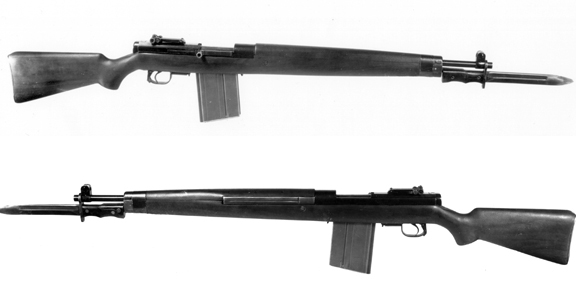
Specs:
Caliber: 7.92mm
Action: Tilting bolt
Length: 45 inches (115 cm)
Magazine capacity: 10 or 20 rounds
Bayonet: British standard No.5
Sights: Aperture
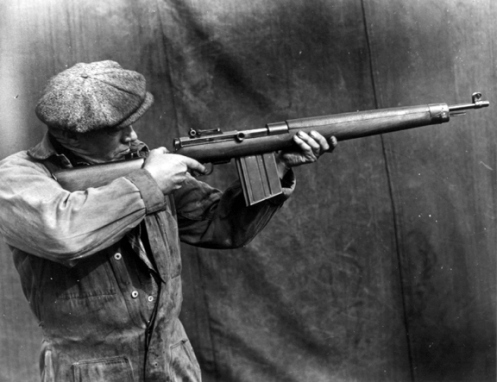
The 1945 SLR (EX-1)
After the rejection of the 1944 model of rifle and a nearly year-long delay, the rifle was redesigned in March of 1945, with this second model ready for trials in May 1945 (another remarkable 3-month development period). This model used a bolt with locking lugs at the front (as opposed to the Bren-style with a locking surface at the rear of the bolt) and apparently was significantly lightened as a result – but was also deemed overly complex and fragile when tested in August 1945. Improvements were made, and by December of 1945 the test rifle had run 800 rounds successfully.
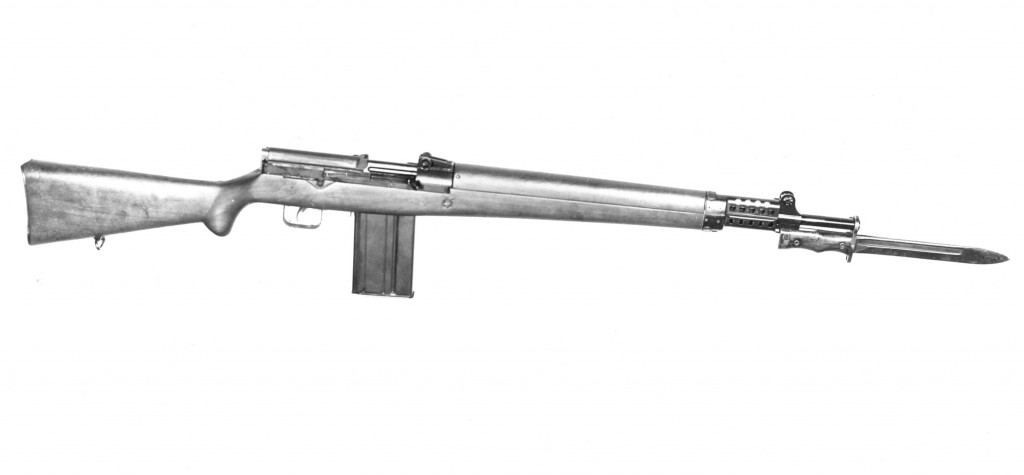
At this point, the Canadian military began to express interest in the rifle, and the Director of Artillery pushed for further funding of the project. Continuing work reduced the rifle’s weight from 10 pounds to 9 (4.5 to 4 kg) and simplified its mechanism. Another trial prototype was scheduled to be ready for testing in April of 1946, but at this point the program began to be overtaken by the competition elsewhere to develop self-loading rifles.
The 1946 SLR (EX-2)
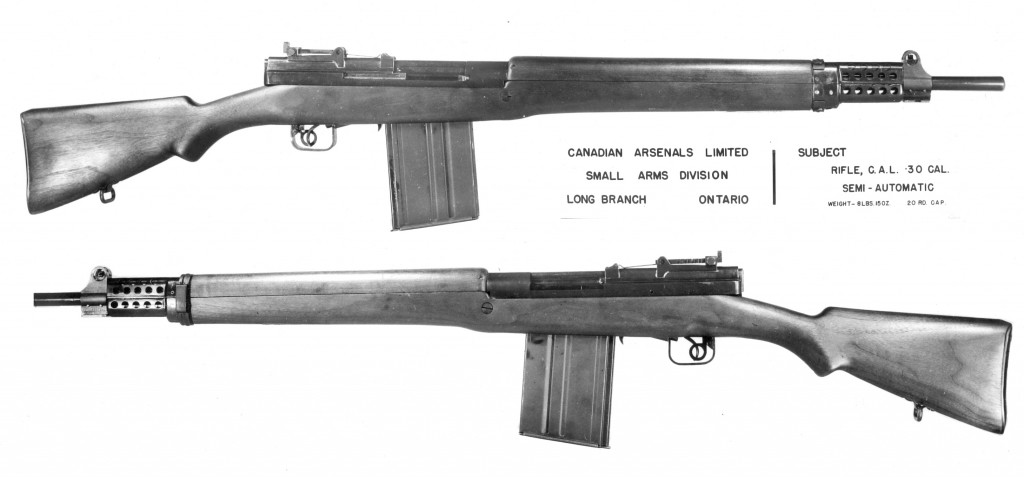
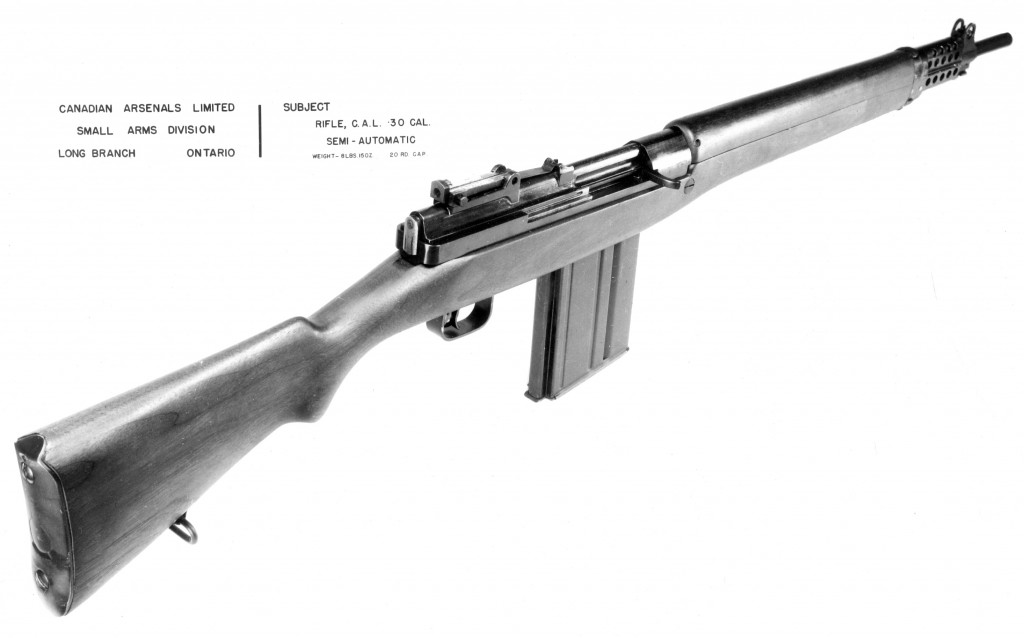

The Long Branch Arsenal and Small Arms Ltd. were dramatically reduced in size shortly after the war ended, and this would have led to the end of theSLR development program. It was decided to continue the work through Canadian Arsenals Ltd., which had taken over operation of the operations at Long Branch. The goal was to rechamber the rifle for the T65 cartridge being pushed by the US, and reduce the rifle’s weight to just 7 pounds (3.2kg). A select-fire option was also to be investigated. This would have conformed to the general NATO rifle program, which would focus on the EM-2, T44 (M14), and T48/FAL rifles.


Ultimately the Canadian rifle experiments here would be overtaken by the FN-FAL and would not see any production beyond the prototype stage. Unfortunately, I do not have any more detailed information on the internals of the various iterations, nor on their trials results.

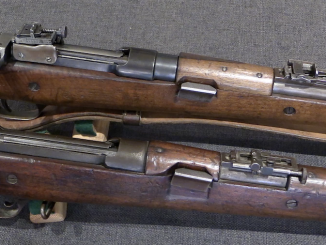

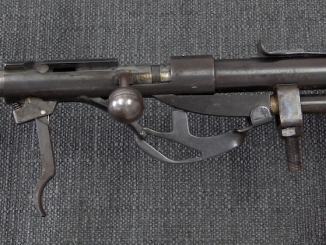
I have know about these for a while and it’s great that you posted this with information as to hy it wasn’t adopted at all.
Looks like every design used the 8mm Bren magazine that the Canadians were supplying with the Chinese 8mm Brens. Same mag as the ZB26/30 guns.
Sorry that is NOT a No.5 British bayonet. The blade tip is incorrect and the barrel ring is too small of diameter. The No. 5 bayonet goes with the No.5 Mk.1 Jungle carbine and Sterling L2A3Mk.4 submachine gun.
It’s definitely not a No.5 bayonet. It also isn’t the No.7 because it doesn’t have the rotating buttcap to lock onto the barrel of the rifle.
Its hilt looks very close to the No. 1 Mk 2 bayonet for the SMLE, but the blade is shorter and shaped more like that of the Model 1907 SMLE bayonet.
Actually, if its lower quillon were longer, it would be a dead ringer for a shortened M1870/87 Italian Vetterli/Carcano bayonet. Which the Italian Army used right through WW2.
My SWAG is that it’s a Canadian pattern of the old standard SMLE bayonet, as opposed to one for the No. 4 rifle. But that’s just a guess.
cheers
eon
I came across an interesting rifle a few years ago – most likely Canadian and if anyone is familiar with the subject I like to hear from him/her… my erstwhile buddy, Billy, bought a No4 Mk1 rifle from one of his buddies who originally had gotten it for ten bux at a local, WPB, FL, garage sale….it appeared to be (in hindsight) a Canadian Ranger rifle. the barrel was cut behind the bayonet lug and the stock shortened to accommodate the new profile…the buttstock was decorated with brass tacks/staples on the LH side in the shape of a bear(the use of tacks to decorate firearms was a common practice among the North American Indians – both Plains & Woodland types). On the RH side of the buttstock there was a scrimshawed brass plate showing two what appeared to be Eskimos – indigenous people – hunting seals. I urged my bud not to try to restore the rifle to the original configuration as it was impossible due to the shortened barrel…I’d buy the gun for $20 AND buy him a surplus No4 Mk1…but he would have no part of it, so he removed the tacks/staples and the brass plate (which my w*fe saved) and after buying the parts from the old Numrich Arms (Gun Parts Inc) turned his interesting rifle into a pile of junk…but he was proud of his work…I wanted to kill him…did the next best thing though…after he broke up with his GF – actually SHE dumped HIM – we bought him a one way ticket back to the Bronx…where her continues to sponge off his buds,,,I’m STILL pissed off about that rifle…it was one of a kind.
Loads of Lee-Enfields were sold off after the war and bought by civilians as hunting rifles in Canada. They were often sporterised before or after sale. That rifle may still have had an interesting history, but it’s anybody’s guess what that might be.
Thanx….it had me wondering even more when I learned of the Canadian Rangers…
SVToid…
Is it just me, or does this Canadian selfloader bear a lot of resemblances to the SAFN battle rifle?
Overall, yes. But the bolt system looks a bit like that of the Tokarev SLR, as does the front end of the gas system. In fact, looking at it and not knowing its origins, you could be excused for thinking it was a Russian design.
cheers
eon
That would be little too early ‘fore-knowledge’ since awareness of Tokarev rifle was not in the West until Korean war.
Well, Denny except if you don’t consider Finland to be part of the ‘West’. Captured SVT (I suppose SVT-40, but 38 might have been sent too) were also allegedly obtained by Spainish technicians during WWII (captured on the Eastern Front).
M.Dieudonne Saive (The true designer of what we call the BHP) spent a few months (when he was allowd to by the British Government) supervising the Manufacture of the ‘Inglis’ Browning High Power…nothing says he couldn’t have contributed to the design of any of these rifles…he WAS working on the SAFN at the time in England
Looks that Canada was not short of talent during and after WWII. What happens, almost by rule is that if there is a sense that ‘danger’ has gone away, the guards go down with it. The consequence is loss of capability. Very much the same happened after Cold War I ended.
Do the NAACO Brigadier next, it was a Canadian project to replace the 9mm Inglis Hi-Power as a service pistol. But instead of doing the obvious and licensing the 1911 or the Webley .455 Self-Loading Pistol, the North American Arms Corporation (no relation to NAA, the current company manufacturing mini-revolvers) came up with something original and very…interesting. It was very nearly an early PDW, and would’ve been one hell of a pistol. See, the NAACO design was more or less a GP35 Hi-Power, except scaled right the hell up and chambered for something very similar to the .45 Winchester Magnum, firing a 230-grain bullet at 1600fps. Even better, there were plans to have a full-auto trigger pack and a detachable stock to convert it to a submachine gun.
Now, all that said, it’d never fly as a service pistol, because even using aluminum parts it was a four-pound monster that only held eight rounds. But damn, it’d have been an interesting gun, the forerunner to the LAR Grizzly and the Desert Eagle. If they’d revived it in the ’70s for silhouette handgunners, and you’d have had something worth selling.
R blake Stevems mentions the NAACO in his Collectors Grace Publication, “The Browning High Power Pistol”…and evidently THIS North American Arms Company (Toronto) wasn’t even the same one that produced the ‘rarest of the rare’ 1911s at the end of the Great War – THAT North American Arms Company was located in Quebec.
I’, currently at work preparing a talk on the BHP for our collector’s club in WPB, FL and reading the Collector Grade Publication book on the High Power by R. Blake Stevens. The director of FN, M. Gustave Joassart, insisted that the British, (with whom the directors & engineers of FN had sought refuge after the fall of Belgium)give FN credit for the design and demanded a royalty of 1.5% on each Inglis HP that was produced for the Chinese Government….England had sought to get around the FN patent by providing drawings of the Belgian HP (copied from an example in their Pattern Room) free of charge to the Canadians. M. Joaassart, realized that if this was allowed to stand, FN would no longer exist as a viable company in the post-war era and would lose what had become its most valuable asset…the exclusive rights to the FN High Power. He approached the British Government with an argument based on his & FN’s legal rights and the British sense of ‘fair play’…it was in England’s (and the Allies) best interests to have a viable FN back up and running in a rebuilding Europe, so In the end the British agreed to M Joassart’s conditions of a 1.5% royalty on each pistol produced and that FN would supply the drawings and technical assistance (Intellectual properties) to the Canadians. Thus Dieudonne Saive & M Joassart came to Canada to supervise and set up the machinery at the John Inglis plant in Toronto….it is entirely conceivable that while M Saive (who, pre-war, was FN’s chief of weapons development – and John Browning’s assistant) was in Canada he also assisted in the development of the Canadian self loaders….the Tokarev, SKS and SAFN & FAL all use the dropping lock locking system. While JMB gets the credit for the BHP it was actually Dieudonne Saive who designed the pistol we know as the BHP…in his lifetime, JMB produced only two tool room models of the p[istol that would bear his name….along story for another time…
A LONG story NOT along story!!! Pardon!!!
The early designs give me feelings I don’t understand. 🙂
does anyone know where these prototypes may be today? Canadian museum?